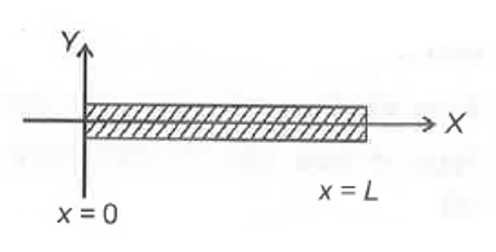A thin bar of length L has a mass per unit length λ, that increases linerarly with distance from one end. If its total mass is M and its mass per unit length at the lighter end is λ0, then the distance of the centre of mass from the lighter end is
L3+λ0L28M
L3+λ0L24M
L2−λ0L24M
2L3−λ0L26M
The correct Answer is:D
To find the distance of the center of mass from the lighter end of a thin bar of length L with a mass per unit length λ that increases linearly, we can follow these steps:
Step 1: Define the mass per unit length
The mass per unit length λ(x) at a distance x from the lighter end can be expressed as:
λ(x)=λ0+ax
where λ0 is the mass per unit length at the lighter end (when x=0), and a is a constant that represents the rate of increase of mass per unit length.
Step 2: Find the total mass
The total mass M of the bar can be calculated by integrating the mass per unit length over the length of the bar:
M=∫L0λ(x)dx=∫L0(λ0+ax)dx
Calculating this integral:
M=∫L0λ0dx+∫L0axdx=λ0L+aL22
Step 3: Express a in terms of M
From the equation for total mass, we can express a:
M=λ0L+aL22⟹a=2(M−λ0L)L2
Step 4: Set up the center of mass equation
The center of mass xcm can be found using the formula:
xcm=1M∫L0x⋅λ(x)dx
Substituting λ(x):
xcm=1M∫L0x(λ0+ax)dx
Calculating this integral:
xcm=1M(∫L0xλ0dx+∫L0ax2dx)
=1M(λ0L22+aL33)
Step 5: Substitute a and simplify
Substituting a into the expression for xcm:
xcm=1M(λ0L22+2(M−λ0L)L2⋅L33)
=1M(λ0L22+2L(M−λ0L)3)
Step 6: Final expression for center of mass
After simplifying, we find:
xcm=2L3−λ0L26M
Final Answer
Thus, the distance of the center of mass from the lighter end is:
xcm=2L3−λ0L26M
The mass per unit length λ(x) at a distance x from the lighter end can be expressed as:
λ(x)=λ0+ax
where λ0 is the mass per unit length at the lighter end (when x=0), and a is a constant that represents the rate of increase of mass per unit length.
The total mass M of the bar can be calculated by integrating the mass per unit length over the length of the bar:
M=∫L0λ(x)dx=∫L0(λ0+ax)dx
Calculating this integral:
M=∫L0λ0dx+∫L0axdx=λ0L+aL22
From the equation for total mass, we can express a:
M=λ0L+aL22⟹a=2(M−λ0L)L2
The center of mass xcm can be found using the formula:
xcm=1M∫L0x⋅λ(x)dx
Substituting λ(x):
xcm=1M∫L0x(λ0+ax)dx
Calculating this integral:
xcm=1M(∫L0xλ0dx+∫L0ax2dx)
=1M(λ0L22+aL33)
Substituting a into the expression for xcm:
xcm=1M(λ0L22+2(M−λ0L)L2⋅L33)
=1M(λ0L22+2L(M−λ0L)3)
After simplifying, we find:
xcm=2L3−λ0L26M
Thus, the distance of the center of mass from the lighter end is:
xcm=2L3−λ0L26M
Topper's Solved these Questions
Similar Questions
The mass per unit length (λ) of a non-uniform rod varies linearly with distance x from its one end accrding to the relation, λ=αx, where α is a constant. Find the centre of mass as a fraction of its length L.
View SolutionThe centre of mass of a non-uniform rod of length L whose mass per unit length λ is proportional to x2, where x is distance from one end

View Solution
Knowledge Check
A rod of length 3 m has its mass per unit length directly proportional to distance x from one of its ends then its centre of gravity from that end will be at
A1.5 mB2 mC2.5 mD3.0 mA rod of length L is of non uniform cross-section. Its mass per unit length varies linearly with distance from left end. Then its centre of mass from left end is at a distance. (Take linear density at left end=0).
 AL3BL6CL2D2L3
AL3BL6CL2D2L3Mass is non-uniformly distributed over the rod of length l, its linear mass density varies linearly with length as λ=kx2. The position of centre of mass (from lighter end) is given by-
A2l/5B3/lC3l/4D2l/3
The mass of an uniform ladder of length l increases uniformly from one end A to the other end B,
find the position of the centre of mass from end A.
View SolutionA thin rod AB of length a has variable mass per unit length ρ0(1+xa) where x is the distance measured from A and ρ0 is a constant.
Find the mass M of the rod.
View SolutionThe linear density of a thin rod of length 1m lies as λ=(1+2x), where x is the distance from its one end. Find the distance of its center of mass from this end.
View SolutionA non–uniform thin rod of length L is placed along x-axis as such its one of ends at the origin. The linear mass density of rod is λ=λ0x. The distance of centre of mass of rod from the origin is :
View SolutionA rod of length 3m and its mass par unit length is directly proportional to the distance x from its one end . The centre of gravity of the rod from that end will be at :-
View Solution
